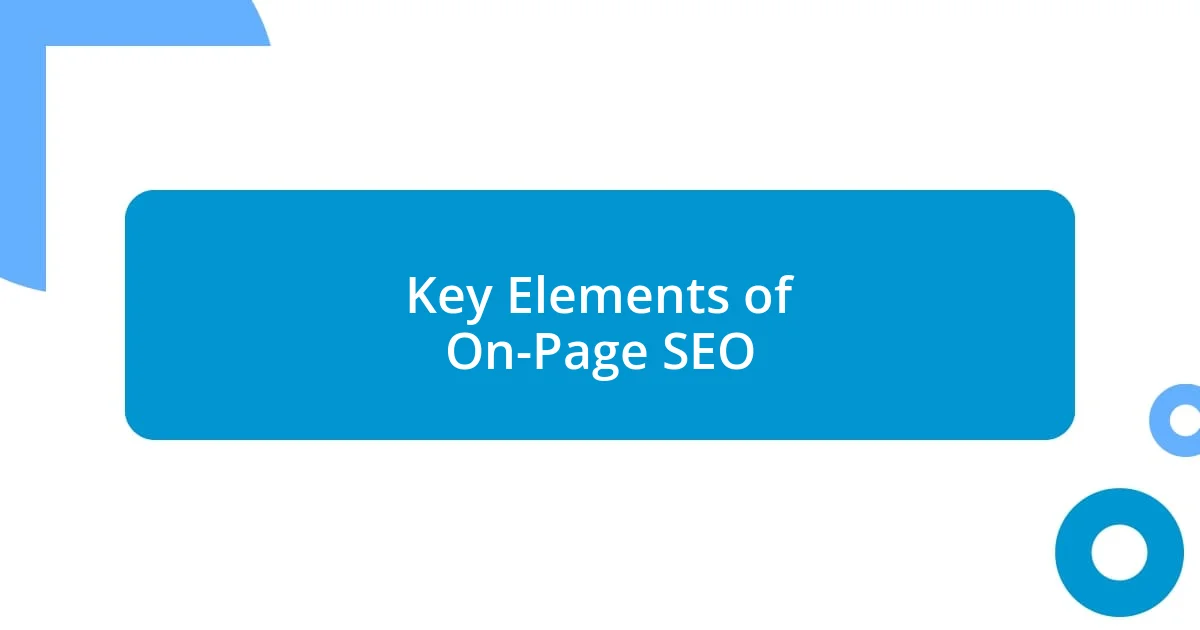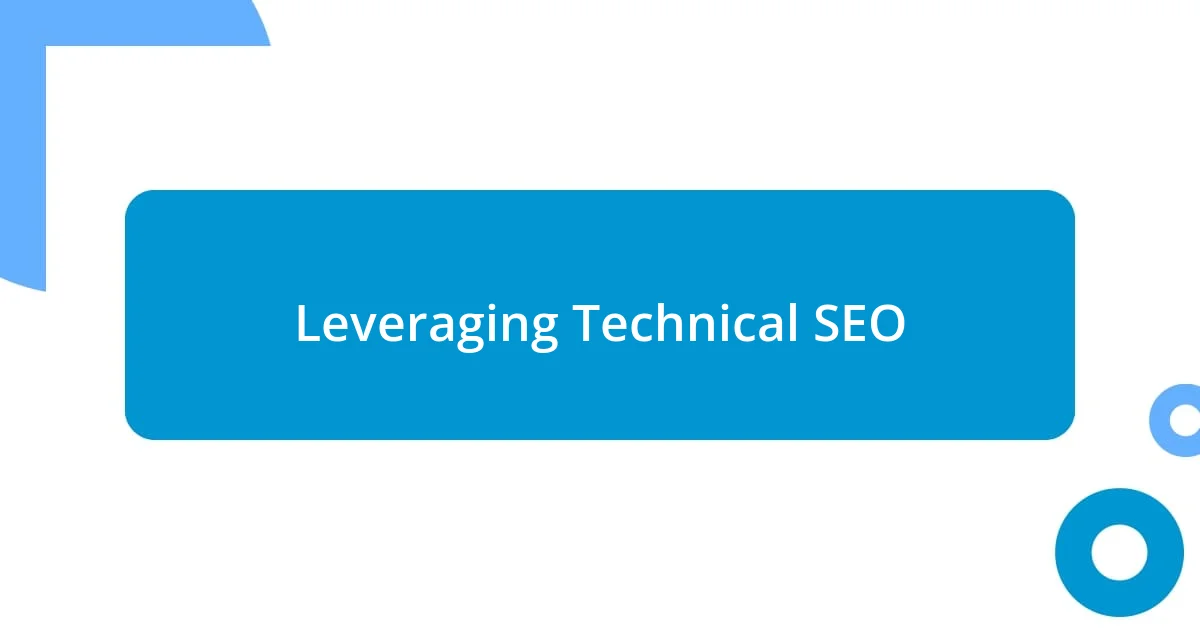Key takeaways:
- Understanding and utilizing keywords, especially long-tail keywords, significantly boosts traffic and content relevance.
- Quality backlinks from authoritative sites enhance credibility and improve search rankings, emphasizing the importance of strong relationships over sheer link volume.
- Regularly monitoring SEO performance through analytics and staying updated with industry trends allows for data-driven decisions and keeps strategies effective and relevant.

Understanding SEO Basics
When I first ventured into the world of SEO, it felt overwhelming. I remember staring at endless lists of keywords and algorithms, wondering where to even begin. But understanding the basics is crucial: SEO, or Search Engine Optimization, is all about enhancing your online presence to ensure search engines like Google can easily find and rank your content.
One key aspect I learned is the significance of keywords. It’s like finding the right voice in a crowded room. You want your content to resonate with what users are actually searching for. I often think back to the time I switched my focus from broad terms to long-tail keywords. The traffic spike was an emotional win, proving that targeting specific phrases made all the difference.
Another fundamental I’ve come to appreciate is the importance of quality content. It’s not enough to just stuff a piece with keywords; your content needs to provide value. Reflecting on my own experiences, I once wrote a detailed guide addressing common pain points in my niche. The feedback was overwhelmingly positive, reinforcing my belief that understanding and catering to your audience’s needs is the backbone of effective SEO.

Key Elements of On-Page SEO
One of the core elements of on-page SEO that I’ve learned over time is the relevance of title tags and meta descriptions. I remember a project where a small tweak in my title tag led to a noticeable lift in my click-through rate. It felt like unlocking a door to a room filled with eager visitors! Crafting compelling title tags that include targeted keywords not only informs search engines about the content of the page but also entices users to click.
Here are some other key elements to keep in mind:
- Header Tags (H1, H2, H3): Organizing content with proper headings improves readability and helps search engines understand the hierarchy.
- Internal Linking: Linking to your own content can keep users engaged longer, and it helps spread link equity across your site.
- Image Optimization: Including alt text for images not only boosts your SEO but also enhances accessibility for visually impaired users.
- URL Structure: Short, descriptive URLs enhance user experience and can improve rankings.
- Content Length: Comprehensive articles tend to rank better, but quality should always take precedence over quantity.
Another insightful feature is optimizing for mobile devices. I vividly recall when I revamped my website to be mobile-friendly. The immediate user engagement increase was thrilling! It highlighted how essential it is to ensure that your content displays well on smartphones, as more users are searching on mobile than ever before. Prioritizing a responsive design can significantly impact your visibility in search results.

Importance of Quality Backlinks
Quality backlinks are the backbone of a successful SEO strategy. From my experience, acquiring backlinks from authoritative sites can significantly elevate your own site’s credibility. There was a period when I focused on creating high-value guest posts with links back to my site. It was gratifying to see my rankings improve as trusted sources began to vouch for my content.
The impact of quality backlinks goes beyond just search rankings; they foster trust and authority in your niche. I remember when a well-respected industry blog linked to one of my articles. It felt like a stamp of approval, and I noticed not only an increase in traffic but also engagement from an audience that felt more inclined to view my content as reliable. This experience reinforced the importance of being selective about where I sought backlinks.
In essence, think of backlinks as endorsements in the digital world. When a reputable site links to you, it communicates to search engines—and users—that your content is worth their time. I’ve learned to prioritize quality over quantity, focusing on relationships with influential site owners rather than chasing after numerous low-value links. This strategy has proven much more effective in building a sustainable online presence.
| Type of Backlink | Impact on SEO |
|---|---|
| Quality Backlinks | High – Establishes authority and trust with search engines |
| Low-Quality Backlinks | Low – Can harm rankings and reduce credibility |

Leveraging Technical SEO
When I first delved into technical SEO, I realized how crucial site speed is for user experience. I remember the moment I ran a speed test on my site and was stunned to see how sluggish it was. It felt like a wake-up call! Implementing strategies like image compression and utilizing browser caching not only improved my loading times but also kept visitors from bouncing away in frustration. Have you ever left a site because it took too long to load? I know I have, and that’s where the problem lies—user patience is wearing thin in our fast-paced world.
Another aspect that I found invaluable is ensuring proper XML sitemaps are in place. After generating and submitting my sitemap to Google Search Console, the impact was immediate and gratifying. Increased crawl efficiency meant search engines could find and index my pages more effectively. It’s like giving them a roadmap to my content treasure! If you haven’t explored sitemaps yet, I highly recommend taking the time to set one up—it can do wonders for your site’s visibility.
I can’t stress enough the importance of mobile optimization within technical SEO. One day, while reviewing my analytics, it struck me that a vast majority of my traffic was coming from mobile devices. I rushed to implement responsive design, and the transformation was impressive! Seeing those engagement metrics climb as users interacted with my content more seamlessly was exhilarating. Have you ever thought about how your website performs on mobile? It’s a game-changer, and neglecting it could mean missing out on a significant audience.

Effective Use of SEO Tools
Utilizing SEO tools effectively has been a game changer in my optimization journey. One of my go-to tools is Google Analytics; I still remember the excitement of uncovering which keywords drove traffic to my site. By tracking user behavior, I could refine my content strategy to focus on what truly resonated with my audience. Have you ever noticed how some keywords pull in more readers? It’s like solving a puzzle that reveals the preferences of your visitors.
Another tool that’s substantially improved my strategy is SEMrush. This tool became indispensable when I began analyzing competitor keywords. It was fascinating to see the gaps I could fill in my own content. I specifically recall the boost in my site’s organic traffic after I wrote a piece targeting a keyword that competitors overlooked. It’s remarkable how a single insight can lead to significant results.
Lastly, I can’t overlook the importance of keyword research tools. Spending time with these tools has allowed me to dive deep into search intent and understand my audience better. I felt a sense of clarity and direction after using tools like Ahrefs; they helped me identify not just what keywords to target, but also how to craft better content around them. How do you approach your keyword strategy? Trust me—taking a moment to use these tools can elevate your SEO game immensely.

Monitoring and Analyzing SEO Performance
Monitoring and analyzing SEO performance is essential for anyone serious about growth. I vividly recall the first time I dived into my site’s analytics and felt a rush of excitement seeing the traffic spikes after implementing a new SEO strategy. The ability to see what worked and what didn’t was empowering—it transformed my approach because I could make data-driven decisions. How often do you reflect on your performance metrics? I’ve found that regularly checking these numbers keeps me in tune with my audience.
Tracking key performance indicators (KPIs) like organic traffic, bounce rates, and conversion rates has been a revelation for me. I remember a phase when my bounce rate was alarmingly high, and it prompted me to revisit my content. By analyzing why users were leaving my site quickly, I discovered opportunities to create more engaging and relevant content. Have you ever felt the frustration of pouring effort into a piece only to see it flop? Adjusting based on performance was a crucial step in turning that frustration into success.
I also find that using tools like Google Search Console offers incredibly valuable insights. When I first received alerts about indexing issues, it felt like opening a door to improvements I never knew existed. Addressing those issues paved the way for better rankings and visibility. Engaging with data doesn’t have to be overwhelming—have you explored what these tools can reveal about your SEO efforts? I promise, the clarity they provide can truly reshape your strategy and boost your results.

Staying Updated with SEO Trends
Staying updated with SEO trends can feel like catching a moving train, but I’ve found that it’s necessary to keep up to speed. I started subscribing to industry newsletters, and let me tell you, there’s something exhilarating about opening my inbox to the latest insights. Just last month, I read about a new Google algorithm update that could change everything; knowing about it ahead of time made me rethink my upcoming content strategy. Have you ever felt the dread of missing out on crucial updates? Trust me, being in the know gives you a competitive edge.
I also make it a habit to participate in SEO forums and webinars. There’s nothing quite like engaging in discussions with fellow marketers who share their real-time experiences. I remember vividly the tips I gathered from a recent webinar where experts explored emerging search trends. Some ideas sparked a light in my brain, prompting me to experiment with voice search optimization. Have you tried taping into the current conversations that shape the SEO landscape? Joining these gatherings not only broadens my knowledge but also refines my strategies through shared insights.
Lastly, I regularly allocate time to read blogs and listen to podcasts from SEO thought leaders. I still recall the first time I came across Marie Haynes’ podcast—her ability to demystify complex topics while maintaining a relatable tone made learning enjoyable. Sometimes, it’s easy to get caught up in the daily grind and forget to step back and absorb new information. How often do you take that moment to refresh your understanding of SEO? I assure you, making this a routine has enriched my approach dramatically, keeping my strategies fresh and relevant in a constantly evolving digital world.












